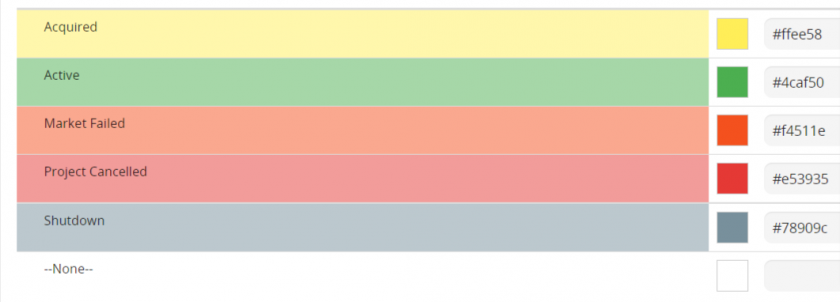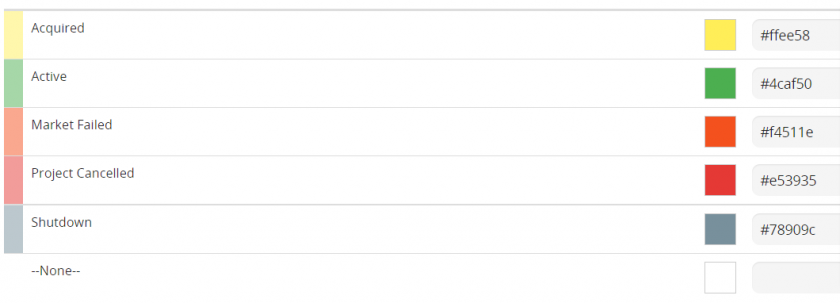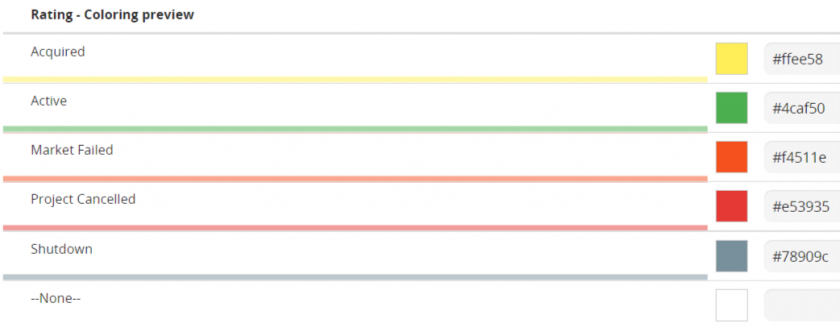|  | Generates the processes that autonomously manage the data flow within the CRM |
|  | Generates automatic actions in the CRM when predefined conditions occur (trigger > action) |
|  | Generates new wizards, which allow the creation and management of records, belonging to different modules and their relationships. |
|  | Generates new modules, manages their content and relationships with other modules, with advanced SDK editing capabilities. |
|  | Accesses the settings of all modules (including extra modules) to enable/disable them and change their layout |
|  | Customises drop-down menus, to add, delete or overwrite values, change their order and visibility by roles |
|  | Manages multi-language drop-down menus |
|  | Creates dependencies between drop-down menus: the choice in the second menu depends on the choice in the first menu |
|  | Management of status changes of CRM items according to constraints and pre-defined authorisations on roles |
|  | Controls the behaviour of fields (visibility, modification, etc.) on the basis of certain conditions |
|  | Protects the values assumed in the fields |
|  | Selects and orders the modules shown in the main navigation menu |
|  | Assigns a colour to the data, based on the values of the picklist fields, which is displayed in the list view of the module, in the Kanban, in the related items and in the dashboards of the homepage. Warning! Only one picklist per module can be assigned to the colours. |
|  | Reads one or more mailboxes and, when a condition occurs, activates automatic mail operations. |
|  | Imports data from CSV files or databases with the option to schedule the process and create advanced queries for data extraction **Warning!** This function is not available in the cloud version. |
| **Managed** | Means managed by the rule, when it occurs. The fields that you do not have to manage should be left disabled; in conjunction with those to be managed, tick the box and proceed with the others. By enabling only this field, without the subsequent ones, the field will be hidden. |
| **Read** | By enable reading permissions, the field will be visible |
| **Write** | By enable writing permissions, the field will be editable |
| **Mandatory** | Makes the field mandatory (function active only in the event of combined use of Status Manager and Conditionals) |
| **Shared Access** | Private or public in various ways; see Sharing Access chapter |
| **Enable Quick creation** | Makes the form available for Quick Creation, in the menu of the bar on the right |
| **Enable Import** | Allows data to be imported from an external source (CSV file) into the module |
| **Enable Export** | Allows you to export module data to CSV files |
| **Enable Duplicate Management** | Allows verification of duplicate data within the module |
|  | Uninstall the module: it will no longer be usable and the records contained within it will be removed |
|  | Change the settings related to the module, repeating the previous steps. This function is only available if the module has not been previously uninstalled |
|  | Export the XML format module (stored in RAR files) |
|  | Delete the module permanently; before being deleted, a module in use must be uninstalled |
| [](https://usermanual.vtenext.com/uploads/images/gallery/2020-05-May/import_button.png) | Import a module saved locally in XML format |
| [](https://usermanual.vtenext.com/uploads/images/gallery/2021-08-Aug/17_7_Layout-Editor_pi%C3%B9.PNG) | Add cusomized field in the module |
| [](https://usermanual.vtenext.com/uploads/images/gallery/2021-08-Aug/17_7_Layout-Editor_calamita.PNG) | Attract fields coming fom other sections |
| [](https://usermanual.vtenext.com/uploads/images/gallery/2021-08-Aug/17_7_Layout-Editor_occhio.png) | Allow to see fields that has been hiden |
| **Text** | It is a field that can contain from 1 to 255 characters (letters and numbers). The desired length and the name to be given therefore need to be defined. |
| **Text Area** | Text field with pre-set dimensions, visual width equal to the card and with a maximum number of characters of 66,000 (letters and numbers) |
| **Number** | It is a field that can contain from 1 to 64 numbers (including decimals). The desired length, the name to be given and how many decimal places to enter and display therefore need to be defined. |
| **Percentage** | The name to be given to the field needs to be defined (it is recommended to insert the % symbol in the label, as a reminder). The field is purely numeric with the impossibility of exceeding 100% |
| **Currency** | The name to be given, the desired length and how many decimal places to enter and display need to be defined |
| **Date** | The name to be given needs to be defined. Activate the datapicker and autocomplete with today's date in the entity creation phase |
| **Email** | The name to be given needs to be defined. Once the email address is saved, if clicked, it will open the predefined composer window to create a new message |
| **Phone** | The name to be given needs to be defined. Once the number is saved, if the switchboard is configured, you will be able to use click-to-call |
| **URL** | The name to be given to the field needs to be defined. Once saved, the URL address allows you to open it in a new tab |
| **Check Box** | This is a YES/ NO flag field. The name to be given needs to be defined |
| **Picklist** | To create a drop-down menu with the fields of your interest. The name to be given to the field and to the values (one below the other) of the list needs to be defined |
| **Skype** | Define the name to be attributed. Once the Skype ID is saved, it will open the chat directly with the ID setted. |
| **Combo multisection box** | To create a drop-down menu where, using the CTRL key, you can select multiple values. The name to be given to the field and to the values (one below the other) of the list needs to be defined |
| **Multilanguage Picklist** | To create drop-down menus, whose values will be available for translation into other languages. The name to be given to the field needs to be defined and then the values (with related translations) created through SETTINGS > MULTI-LANGUAGE PICKLIST EDITOR |
| **User** | The name to be given needs to be defined. It is used to insert an additional link to the entity with a user |
| **User without filtering permits** | The name to be given needs to be defined. It is used to add a link between the entity and a user by bypassing roles and permissions |
| **User from filtered list** | The name to be given needs to be defined. It is used to add a link between the entity and one of the users defined upstream |
| **Group** | The name to be given needs to be defined. It will provide a drop-down menu with any available groups |
| **Button\*** | Allows you to create a button that recalls a custom function. You need to enter the code during creation *\*see also 17.7.1 BUTTON field in vtenext* |
| **Table Field** | It allows you to create table fields, which permit you to insert lines with values of choice, recalling them from the modules or creating them specifically |
| **Attach documents** | It allows you create a field for adding documents at the same time as creating an entity |
| **Full row** | [](https://usermanual.vtenext.com/uploads/images/gallery/2021-12-Dec/17_13-List-view-colours_1.png) |
| **Little block on the left** | [](https://usermanual.vtenext.com/uploads/images/gallery/2021-12-Dec/17_13-List-view-colours_2.png) |
| **Thin line** | [](https://usermanual.vtenext.com/uploads/images/gallery/2021-12-Dec/17_13-List-view-colours_3.png) |
| **Scanner Nome** | Indicate the name, as preferred, to be given to the scanner |
| **Server Nome** | Enter the address of the IMAP mail server, for example: mail.dominiocompany.it |
| **Protocol** | Indicate IMAP4 or IMAP2 |
| **User Name** | Enter the User Name to access the inbox; it usually matches the email address |
| **Password** | Enter the inbox access password |
| **SSL Type, SSL Method** | Indicate the access security protocol information if required |
| **Parameters** | It is used to configure advanced parameters for the imap connection, without using the code. Example: - Parameter name: DISABLE\_AUTHENTICATOR - Parameter value: PLAIN |
| **PEC** | Indicate that the current email address is a PEC By enabling the flag. In this way the ticket will be created using the original email, that is the one contained in the attatched .eml file. |
| **Status** | Enable = mailbox scan is active; Disable = mailbox scan is not active |
| **Find** | Indicate if: - All = all emails after the last scan - Not read = only emails not read after last scan |
| **After Scanning** | Allows you to indicate whether to change the status of the email after scanning: - Empty = does not change the status - Read = the email is marked as read |
| **From** | Indicate a condition in the From field: (sender), if not present leave the field blank |
| **To** | Indicate a condition in the To field: (recipient), if not present leave the field blank |
| **Subject** | Indicate a condition in the Object field, if not present leave the field blank |
| **Body** | Indicate a condition in the body of the email, if not present leave the field blank |
| **Match** | Indicate: - Any Condition: at least one condition must be true (OR) - All conditions: all conditions must be true (AND) |
| **Action** | Indicate the action to be taken when conditions occur. - Create a ticket: Create a ticket from an email, with the following features: - Connected to: the Contact is inserted on the basis of the sender's email address; if not present it remains empty - Title: subject matter of the email - Description: body of the email - Documents: any attachments to the email - Update Ticket: update an existing ticket - Add TO/ FROM: file the email by linking it to the Lead/Account/Contact registry with a check on the email address of the sender \[FROM\] or the recipient \[TO\] of the mail |
| **Mark as Spam** | In this way the email address of the sender will be put in spam. Furthermore, the ticket will be delated. |
| **Answer by mail** | It allows to reply to the email with the email address of the user that is carrying out that operation and not with the email set in the Mail Converter. |
| **Answer by Mail (Info)** | It allows to reply to the customer directly with the email address set in the Mail Converter. In this way, we will be able to track the exchange of communications in the ticket. |
| **Order Num.** | **Product Num** | **Name** | **Descr.** | **Q.ty** | **Price** | **Disc.** | **Total row** |
| SO10 | PR07 | TV | Model 123 | 2 | 350,00 | 0 | 700,00 |
| SO10 | PR11 | Mixer | Bland everything | 1 | 90,00 | 15 | 75,00 |
| **Order Num.** | **Product Num** | **Name** | **Descr.** | **Q.ty** | **Price** | **Disc.** | **Total row** |
| SO10 | PR07 | TV | Model 123 | 2 | 350,00 | 0 | 700,00 |
| SO10 | PR11 | Mixer | Bland everything | 1 | 90,00 | 15 | 75,00 |
| SO11 | PR05 | Computer | Super PC | 1 | 300,00 | 50 | 250,00 |
| SO11 | PR11 | Mixer | Bland everything | 1 | 25,00 | 0 | 25,00 |
| **Order Num.** | **Product Num** | **Name** | **Descr.** | **Q.ty** | **Price** | **Disc.** | **Total row** |
| SO10 | PR07 | TV | Model 123 | 2 | 350,00 | 0 | 700,00 |
| SO11 | PR05 | Computer | Super PC | 1 | 300,00 | 50 | 250,00 |
| SO10 | PR11 | Mixer | Bland everything | 1 | 90,00 | 15 | 75,00 |
| SO11 | PR11 | Mixer | Bland everything | 1 | 25,00 | 0 | 25,00 |
|  | Import enabled/disabled (to change, click on the icon) |
|  | Start import now |
|  | Changing the configuration (the previous steps are re-proposed) |
|  | Reading the last import report |
|  | Delete the Import |